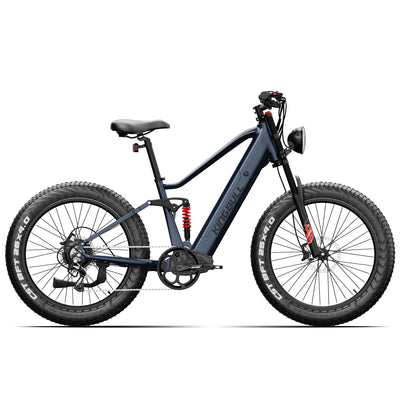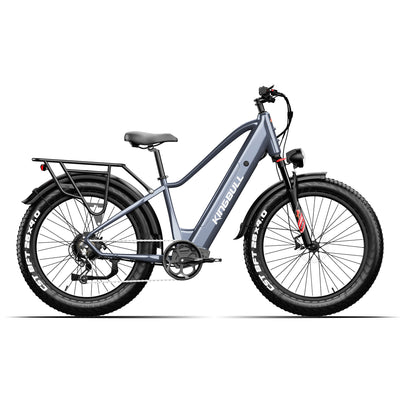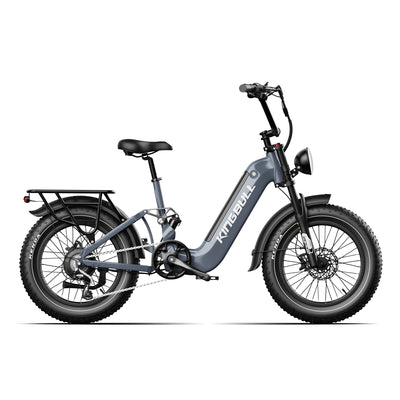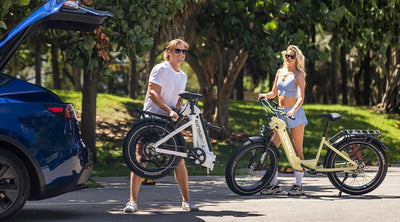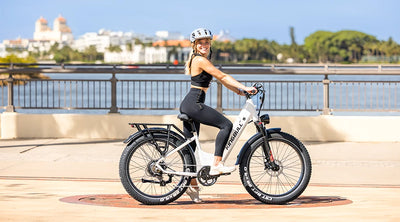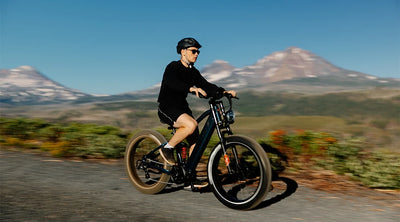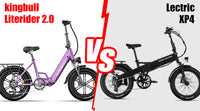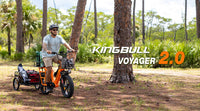Explore News

Green Commuting: An Overview of California Electric Bicycle Laws
California, renowned as a pioneer in innovation and sustainable transportation, has consistently been at the forefront of progressive regulations and policies. In recent years, electric bicycles have rapidly risen to prominence on the state's roads, becoming an increasingly popular mode of transportation. However, as electric bicycles gain widespread adoption, the associated regulations and provisions are continually evolving to accommodate the development of this emerging means of transportation. This article explores the recent developments in California's electric bicycle regulations, aiming to help you better understand the rules governing electric bicycles in the state.
The Definition of Electric Bikes
In California, an electric bicycle (e-bike) is defined as a unique mode of transportation categorized based on its electric assist system. An electric bicycle is a novel form of conveyance that combines human pedaling with electric assistance, characterized by the incorporation of an electric assist system providing additional power support during cycling. In comparison to traditional bicycles, the electric bicycle's electric assist system allows riders to more effortlessly conquer inclines, undertake long-distance rides, or navigate through adverse weather conditions.
Nevertheless, distinctions from motorcycles are evident in the case of electric bicycles. Firstly, the electric assist system of an electric bicycle is designed to complement human pedaling rather than entirely replace it. Secondly, California regulations specify maximum speed limits for electric bicycles, ensuring that, even with electric assistance, they maintain relatively lower speeds. This characteristic serves to differentiate electric bicycles from motorcycles, which typically possess higher speeds and more powerful propulsion systems.
Hence, electric bicycles represent a distinctive mode of transportation, inheriting the environmentally friendly and health benefits of traditional bicycles while providing enhanced convenience through the electric assist system. In California, the precise definition of electric bicycles forms the foundation for their lawful operation on roadways, fostering a relatively safe and organized traffic environment for riders and other road users.
Classes Of Electric Bikes
In California, electric bicycles are classified into three main categories: Class 1, Class 2, and Class 3. The classification is based on key factors such as the level of electric assistance, maximum speed, and the method of initiating electric assistance.
Class 1 Electric Bicycles
Class 1 electric bicycles are typically defined as "electric assist bicycles," with the electric assistance system only providing support when the rider is pedaling. The maximum assisted speed for these bicycles is generally limited to 20 miles per hour, and the assistance is automatically initiated when the rider begins pedaling. The design of Class 1 electric bicycles aims to offer riders an effortless cycling experience while maintaining reasonable control over speed and initiation.
Class 2 Electric Bicycles
Class 2 electric bicycles are defined as "electric assist bicycles," where the electric assistance system supports the rider while pedaling and can also be manually controlled. The maximum assisted speed is typically restricted to 20 miles per hour, but riders have more control, being able to manually start and stop the electric assistance system as needed.
Class 3 Electric Bicycles
Class 3 electric bicycles are defined as "electric assist bicycles" with an electric assistance system that can provide support without pedaling. The maximum assisted speed is generally limited to 28 miles per hour, and these bicycles come equipped with manual controls, allowing riders to flexibly start or stop the electric assistance. Class 3 electric bicycles offer greater flexibility and power support, suitable for a wider range of cycling scenarios.
This classification system helps clarify the characteristics of different types of electric bicycles, providing riders with more options while ensuring safety and compliance on the roads. When purchasing electric bicycles, riders can choose a vehicle that aligns with their cycling needs and regulatory requirements.
Compliance with Regulations
In adherence to California's regulations governing electric bicycles, particularly Class 3 e-bikes, specific requirements must be observed:
Class 1 and Class 2 electric bicycles in California are subject to specific regulations regarding registration, safety standards, and maximum speed. Class 1 electric bicycles do not require registration, have a maximum speed limit of 20 miles per hour, and riders are required to wear helmets; they are allowed to use bicycle lanes. Similarly, Class 2 electric bicycles also do not require registration, have a maximum speed limit of 20 miles per hour, and riders must wear helmets; they are permitted to use bicycle lanes on public roads. These regulations aim to provide clear guidelines for the registration, safety, and speed parameters of Class 1 and Class 2 electric bicycles, ensuring compliance and safety on California roads.
Class 3 e-bikes are restricted from being ridden on bicycle paths, trails, bikeways, or bicycle lanes unless located within or adjacent to a roadway. Operators and passengers of Class 3 e-bikes are obligated to wear helmets for safety compliance. Furthermore, individuals under the age of 16 are prohibited from operating Class 3 e-bikes. Notably, there are no restrictions on riding these bikes on sidewalks. However, Class 3 e-bikes cannot be operated on certain paths or trails unless within or adjacent to a roadway, or unless authorized by local ordinances.
Local authorities or governing bodies overseeing bicycle paths, equestrian trails, or hiking/recreational trails may enact ordinances to either permit or prohibit the operation of Class 1 or Class 2 electric bicycles on those specific paths or trails. Additionally, all e-bikes are required to have a prominently displayed label indicating the class level, top assisted speed, and total electric motor wattage or power output. For night riding, bikes must be equipped with lights and reflectors. Class 3 e-bikes are also mandated to have a speedometer, and all riders must wear helmets when operating these bikes. These regulations collectively ensure the safe and responsible use of Class 3 e-bikes in accordance with California law.
Kingbull Reminds You to Ride Safely
Wear a Helmet and Dress in Bright Clothing for Increased Visibility
Wearing a helmet is a crucial step in protecting your head from injuries. Helmets should be worn correctly to provide optimal protection. Additionally, dressing in bright clothing and using reflective gear can make you more visible to other road users. This is particularly important when riding during dusk, at night, or in low visibility conditions.
Obey Traffic Rules, Including Traffic Lights and Signs
Adhering to traffic rules is essential for road safety and order. This includes stopping at red lights, following traffic signs, and obeying the direction of travel. Electric bike riders are expected to respect traffic regulations just like motor vehicles.
Avoid Speeding and Adjust Speed According to Road Conditions and Traffic
Electric bikes often have good speed potential, but riders should adjust their speed based on road conditions, traffic density, and weather factors. Avoid speeding, especially on busy streets or in areas with speed limits, to reduce the risk of emergencies.
Avoid Distracted Riding, Do Not Use Phones or Headphones
Distracted riding is a major cause of accidents. Avoid using your phone, wearing headphones, or engaging in other attention-diverting activities while riding. Stay focused on the road and traffic conditions to be able to respond promptly to potential hazards.
Regularly Check the Electric Bicycle's Brakes, Tires, and Lighting System
The safety of electric bikes relies on the proper functioning of critical components. Regularly check the brake system, tire pressure, wear, and ensure that the front and rear lights are working correctly. Maintaining the electric bicycle can reduce the risk of accidents caused by mechanical failures.
Avoid Riding on Unsuitable Surfaces and Use Bike Lanes
Riding on unsuitable surfaces, such as muddy trails or roads with fast-moving vehicles, can lead to instability and accidents. Riders should strive to use bike lanes to minimize contact with motor vehicles but also comply with lane-specific regulations and traffic rules.electric bike riders can reduce the risk of accidents by adopting these preventive measures to protect their safety and that of other road users. Adhering to traffic regulations, staying focused, regular bicycle maintenance, and wearing appropriate safety gear are key steps in ensuring safe riding. These practices will help prevent electric bike accidents and enhance your riding safety. Remember, safety always comes first when riding electric bikes. Click here for detailed cycling safety tips.
Conclusion
In summarizing the regulations for electric bicycles in California, we not only observe clear definitions and standards for different categories of e-bikes but also recognize that these regulations are designed to enhance the safety and orderliness of riders on the roads. Through the specification of e-bike classifications, speed limits, designated usage areas, and safety requirements, the regulations ensure the legality and manageability of electric bicycles within the transportation system.
Simultaneously, these regulations provide riders with choices and flexibility, allowing them to select the e-bike type that best suits their personal needs and preferences. With the continual advancement of technology and increasing societal focus on sustainable modes of transportation, the future prospects for electric bicycles in California are undoubtedly vibrant.
Read more

Tips & Cycling Knowledge
Ebike Regulations in the United States: The Essentials You Need to Know
With the continuous advancement of technology, electric bikes are becoming an increasingly popular choice for eco-friendly commuting in the United States. However, behind the joy of riding lies a complex web of regulations that varies from state to state. This article delves deep into the regulations governing electric bikes across the United States, shedding light on the evolving landscape that riders and manufacturers must navigate. From speed limits to age requirements, we will uncover the intricacies of electric bike regulations, providing you with a comprehensive legal map to ensure a worry-free ride in the future of electric commuting.
What is an Electric Bike
An electric bike is defined as a bike equipped with an electric assist system that can be operated through pedals or handles, assisting the rider during cycling, rather than a purely electrically propelled electric vehicle. This electric assist system typically does not exceed a specified power limit, with federal regulations stipulating a maximum motor power of no more than 750 watts.
The Three Classes of Electric Bike Regulations
To ensure the safe operation of electric bikes on the road and compliance with regulations, a common and beneficial classification system divides electric bikes into three categories: Class 1, Class 2, and Class 3. The establishment of this classification system is not merely aimed at categorizing types of electric bikes; rather, it serves to create a unified set of standards among electric bikes with different designs and performances. This system contributes to ensuring their safe and controlled use on public roads. These three classifications are based on pedal assistance, handlebar throttles, and maximum assisted speed, providing a clear foundation for the formulation of relevant regulations and riding standards.
Class 1: This type of electric bike is equipped with a pedal-assist system, supporting the rider during cycling through pedal operation. Its maximum assisted speed is typically restricted to 20 miles per hour.Class 2: These electric bikes are equipped with a pedal assist and throttle, allowing direct electric propulsion using a handle, rather than through pedal operation. Similarly, the maximum assisted speed is limited to 20 miles per hour.Class 3: Electric bikes of this type have a pedal-assist system, but their maximum assisted speed can reach 28 miles per hour.
As of July 2023, legislation creating the class system has been passed in forty one states: Alabama, Arizona, Arkansas, California, Colorado, Connecticut, Delaware, Florida, Georgia, Idaho, Illinois, Indiana, Iowa, Kansas, Louisiana, Maine, Maryland, Massachusetts, Michigan, Minnesota, Mississippi, Missouri, Nebraska, Nevada, New Hampshire, New Jersey, New Mexico, New York, North Dakota, Ohio, Oklahoma, South Dakota, Tennessee, Texas, Utah, Vermont, Virginia, Washington, West Virginia, Wisconsin and Wyoming. Click here to explore the differences in electric bicycle regulations across states. ( Note: This table has been compiled by PeopleForBikes.)
Class 1
Class 2
Class 3
Max Speed
20MPH
20MPH
28MPH
Power Delivery
Only Pedal Assist
Both Pedal Assist & Throttle
Only Pedal Assist
Note: The three class system also creates rules governing the use of electric bicycles, with safety asthe top priority. Class 1 and 2 electric bicycles would be permitted to travel anywhere traditional bikes are permitted, as the maximum assisted speed of these devices is closely aligned with speeds traveled by traditional bicycles. Class 3 electric bicycles could be ridden on streets and roadways where traditional bicycles are permitted, including bicycle lanes, but would be restricted from slower speed areas such as multi-use paths. Class 3 electric bicycles would also be subject to additional requirements, such as a minimum user age and helmet mandate. Electric bicycles would not be subject to any licensing, registration, or insurance requirements.
The Regulations for Ebike in Other States
Due to variations in laws and regulations across each state, we will now conduct in-depth research on an additional 9 states to gain a more comprehensive understanding of the diversity in electric bicycle regulations. This will include a detailed analysis of the definitions, registration requirements, riding restrictions, and other regulations that may impact electric bicycle users and the industry. The aim is to provide readers with specific and targeted information, helping them better adhere to local legal requirements when using electric bicycles.
Alaska
In Alaska, electric bikes, referred to as "motor-driven cycles," have distinct regulations from traditional bicycles. E-bike riders must possess an operator's license, and although they are not required to adhere to the same rules of the road as traditional bicycles, they are not subject to registration or insurance requirements. Helmets are not mandatory, but there is a minimum age requirement of 14 years for e-bike use. Additionally, e-bikes are prohibited from using sidewalks and bike paths in Alaska. These specific regulations aim to define and manage the use of electric bikes within the state, ensuring a clear framework for riders and promoting safety on the road.
Hawaii
In Hawaii, an e-bike is officially categorized as a "low-speed electric bicycle," defined by its maximum assisted speed of less than 20 mph on a paved level surface when powered solely by its motor. E-bike owners in Hawaii are obligated to register their vehicles, and this process involves paying a $30 fee at designated locations such as any city hall satellite location or the state business registration unit in Honolulu. However, registration is only open to individuals who are at least 18 years old. Those aged 15 and older are allowed to operate a registered e-bike if it is registered to a household member. Notably, helmets are compulsory for riders under the age of 16, reinforcing safety measures for e-bike users in the state.
Kentucky
In Kentucky, electric bikes are officially classified as "mopeds." Whether or not they have pedals, these bikes must not exceed 50 cc, do not require clutching by the operator, and are restricted to a maximum speed of 30 mph. For e-bike riders under the age of 16, an instruction permit is mandatory. Additionally, any individual under the age of 21 must wear a helmet while operating an electric bike. These regulations underscore safety measures for younger riders. Moreover, electric bikes in Kentucky must be operated on roadways where the posted speed limit is less than the maximum output of the motorized device, ensuring a controlled and safe riding environment.
Montana
In Montana, electric bicycles are defined as bicycles equipped with two operational pedals and an attached motor. The power source of the motor should not propel the device, unassisted, at a speed exceeding 20 mph on a level surface, and the motor must not require clutching or shifting. Essentially treated as bicycles for regulation and enforcement purposes, e-bikes in Montana do not require a license or registration. They are permitted to be ridden on roadways and bicycle paths without age restrictions specified by state law.
Montana law mandates that the operator of a motorcycle or quadricycle under the age of 18 wear a helmet, but e-bikes are not classified as motorcycles or quadricycles. Therefore, there is no age restriction for the operation of electric bicycles in Montana. Additionally, electric bicycles are allowed on roadways and bicycle paths, including state park paths, providing riders with the flexibility to navigate various routes for their convenience.
North Carolina
In North Carolina, electric bikes, defined as "electric assisted bicycles," must have a motor under 750w, a maximum speed of 20mph, and operable pedals. Both e-bikes and human-powered bicycles follow the same rules of the road. E-bikes are exempt from registration, licensing, or insurance requirements applicable to motor vehicles. While helmets are not obligatory, the minimum age for e-bike use is 16 years. E-bikes are permitted on sidewalks if bicycles are allowed, but state law does not explicitly address their allowance on bike paths. Individuals should consult their local authority or agency for information regarding whether e-bikes are allowed on bike paths.
Oregon
In Oregon, electric bikes, categorized as "electric assisted bicycles," are regulated like bicycles as long as the motor's maximum power output is 1,000w, the bike has pedals propelled by human power, and the speed does not exceed 20mph. E-bikes are exempt from registration, licensing, or insurance requirements applicable to motor vehicles. They are permitted on bike paths but not allowed on sidewalks. The minimum age for e-bike riders is 16 years, and helmet usage is not mandatory for e-bike riders.
Pennsylvania
In Pennsylvania, electric bikes, defined as "pedalcycles with electric assist," are regulated as long as the motor is under 750w, has a maximum speed of 20mph when powered by the motor source only on a level surface, weighs no more than 100 lbs, and has operable pedals. Both e-bikes and human-powered bicycles adhere to the same rules of the road. E-bikes are exempt from registration, licensing, or insurance requirements applicable to motor vehicles. Helmets are not obligatory, but individuals under 16 years of age are prohibited from operating an e-bike. E-bikes are permitted wherever bicycles or "pedalcycles" are allowed, including sidewalks, although local rules and regulations may impose restrictions.
Rhode Island
In Rhode Island, electric bikes, termed "electric motorized bicycles," are vehicles defined by a power output no greater than 1,491w, a maximum speed of 25mph, and fully operable pedals. E-bikes are exempt from the laws applying to "motor vehicles" and are not required to be registered. They adhere to the rules of the road that apply to "vehicles." The state law does not specifically address whether e-bikes are permitted on bike paths, and individuals are advised to consult local authorities or agencies for information regarding the permissibility of e-bikes on bike paths.
South Carolina
In South Carolina, e-bikes do not have a specific classification under current traffic laws but are considered "vehicles" and are subject to the requirements applicable to vehicles. E-bikes equipped with motors producing less than 750 watts are specifically exempt from the definition of "moped," meaning they are not subject to requirements such as licensing and registration imposed on mopeds. E-bikes adhere to the rules of the road that apply to vehicles. Individuals are encouraged to consult local authorities or agencies for more information about e-bike regulation in their jurisdiction, including whether they are permitted on bicycle paths.
Are Kingbull Electric Bike Legal
We proudly announce that Kingbull electric bikes comply with the regulations governing electric bikes in the United States. According to U.S. electric bike regulations, the motor power of electric bicycles must not exceed 750 watts, and our motor precisely meets this standard. Additionally, we have a thorough understanding that different states in the U.S. may have varying regulations for electric bikes, such as adjustments to the maximum riding speed. Therefore, the maximum riding speed of our electric bicycles is set at 28 mph.
By ensuring that our electric bicycles meet regulatory requirements, we are committed to providing customers with a safe, legal, and compliant means of transportation. Our products not only meet regulatory standards but also prioritize user experience, ensuring that users can enjoy convenient and legal commuting within the specified limits when using our electric bikes.
Conclusion
The above is a summary of electric bike laws and regulations in various states across the United States. Please note that the information provided here is general, and for accurate and up-to-date details, refer to local regulations and ordinances. If there are any errors or updates, feel free to leave a comment to help us improve this information. Ride safely, adhere to local regulations, and enjoy the convenience of electric bike commuting.
Read more

Ebike ComparisonPurchase Guide
Kingbull Voyager VS Aventon Abound: Which One Is The Best?
When it comes to urban commuting and cargo transportation, e-bikes have become a popular choice. They are renowned for their environmental friendliness and convenience, providing city residents with a more sustainable mode of transportation. In this category, Cargo electric bikes stand out as a solution designed for transporting goods and small cargo, and they are increasingly common on city streets. However, the market offers a variety of Cargo electric bike brands and models, each with its unique features and functions.In this article, we will focus on comparing Kingbull Voyager and Aventon Abound. We will delve into their performance, design, pricing, and other key aspects to assist you in finding the electric bike that best suits your needs among the myriad of choices. Whether you are a city dweller, a business operator, or someone in search of a reliable transportation solution, this article will provide you with comprehensive information about these two electric bikes so that you can make an informed decision.
Performance Overview
Kingbull Voyager
Aventon Abound
Battery
48V 17.5Ah lithium battery
48V 17.5Ah lithium battery
48V, 15Ah LG Cells
Motor
750W
750W
Frame
6061 Aluminum frame with integrated battery design
Double-Butted Aluminum Alloy
Weight
77 lbs
81 lbs
Payload Capacity
440 lbs
440 lbs
Wheels
20″ x 4″ CST fat tires
20 x 2.4
Brakes
180mm hydraulic disc brakes
Hydraulic
Pedal Assist
5 Levels
4 Levels
Gears
7-speed
7-speed
Sensor
Speed
Torque
Throttle
Thumb Throttle
Thumb Throttle
Top Speed
28 MPH
20 MPH
Range
Up to 100 miles(Dual battery)
Up to 50 Miles
Step-Through
Yes
Yes
Lights
Integrated front and rear lights with turn signal functionality
Integrated front and rear lights with turn signal functionality
Display
LCD Colorful screen with USB
LCD Smart "Easy Read"
Price
$1,199
$1,999
we will delve into a detailed comparison of these key specifications to uncover how even minor differences in factors such as the motor and gears can interact to create distinct riding experiences. These subtle variations can have a significant impact on your daily commuting and cargo transportation, so let's explore these intricacies together to assist you in making an informed choice.
Battery
The Kingbull Voyager features a single 48V 17.5Ah lithium battery and offers the advantage of a higher battery capacity compared to the Aventon Abound. On the other hand, the Aventon Abound uses 48V, 15Ah LG Cells, which are known for their reliability. If you're looking for an extended riding experience, This higher battery capacity on the Kingbull Voyager not only ensures a longer riding range but also offers the flexibility to extend your rides even further. For those who desire an exceptionally enduring and uninterrupted riding experience, Kingbull Voyager presents the option to complement its already impressive battery with an additional 48V 17.5Ah lithium battery. This means that you can significantly extend your journey and maximize your time on the road, making it an excellent choice for those who require extended riding durations or have heavy cargo to transport.
Motor
Both the Kingbull Voyager and the Aventon Abound are equipped with robust 750W rear hub motors that provide ample power and support for your rides. These motors, operating at 48V, excel in providing strong and reliable assistance, even on challenging terrains and rough roads. With their 750W power, you can expect an efficient and powerful riding experience, ensuring you have the support you need when it matters most.
Frame
The Kingbull Voyager features a robust frame crafted from durable 6061 aluminum material. What sets it apart is its integrated battery design, seamlessly blending the battery into the frame. This not only enhances the structural integrity but also adds to its aesthetic appeal. Moreover, the Voyager incorporates an elevated rear-seat frame design and unibody techniques, a clever feature that elevated rear-seat frame design significantly enhances the overall stability of the bike. This design minimizes the risk of tipping, especially during rides on flat surfaces or uphill climbs. These attributes make the Kingbull Voyager a more reliable and secure choice, particularly well-suited for scenarios that demand added stability, such as cargo transportation or transporting children. The unibody design is a rare and unique feature in the market. This distinctive construction not only enhances the overall sleekness of the bike's appearance but also delivers a more stable riding experience for cyclists. The innovative design seamlessly integrates various components, improving the structural strength of the entire bike and providing riders with outstanding maneuverability.On the other hand, the Aventon Abound employs a double-butted aluminum alloy for its frame, providing a solid structure with excellent durability. However, it should be noted that the Abound's frame design falls slightly short in terms of an elevated rear-seat frame, which may require extra caution when carrying cargo or passengers to maintain stability. Although its frame design leans toward a more traditional approach, the Aventon Abound remains an outstanding electric bike option.
Weight & Payload Capacity
When comparing the weight and payload capacity of the Kingbull Voyager and the Aventon Abound, it's evident that there is minimal difference between the two. The Kingbull Voyager weighs 77 lbs, while the Aventon Abound is slightly heavier at 81 lbs. In terms of payload capacity, the Kingbull Voyager can carry up to 440 lbs, while the Aventon Abound can handle 440 lbs too. This slight variance in weight and payload capacity is unlikely to significantly impact the overall riding experience. Both electric bikes offer impressive load-bearing capabilities, making them well-suited for various applications.
Wheels
Comparing the tires of Kingbull Voyager and Aventon Abound electric bikes, it's evident that there are significant differences between them. Kingbull Voyager is equipped with 20″ x 4″ CST fat tires, while Aventon Abound utilizes 20" x 2.4" Puncture-Resistant tires.Kingbull Voyager's CST fat tire design is aimed at providing a larger contact area and better traction, especially suitable for various road conditions, including rough, uneven surfaces, and adverse weather conditions. These tires not only offer excellent traction but also provide greater stability, making them highly suitable for transporting cargo or riding on challenging road conditions. The Voyager tires features an unibody wheel design, this advanced design not only enhances the durability of the tire but also improves the overall performance of the e-bike. Moreover, the integrated wheel design contributes to providing more stable handling, allowing the Voyager to perform exceptionally well on various terrains. This innovative wheel design ensures a smoother, more reliable riding experience.
Aventon Abound's 20" x 2.4" Puncture-Resistant tires prioritize smoothness and puncture resistance. These tires have lower rolling resistance and incorporate puncture-resistant features to reduce the risk of tire pressure loss due to punctures. While they may not excel in traction as much as Kingbull Voyager, these puncture-resistant tires offer reliable performance for urban riding and long-distance journeys.
Brakes
Both Voyager and Abound feature advanced hydraulic brake systems, which excel in braking performance, providing riders with exceptional control to ensure speed management and safe stops during rides.
Sensor & Throttle
Voyager utilizes a speed sensor, which provides assistance by detecting the rider's pedaling motion. This sensor delivers a smooth and natural riding experience, allowing you to start your journey with ease and gradually feel the electric assistance kicking in. The sensor's quick response makes riding smarter and more adaptive, making it well-suited for various scenarios, whether you're carrying children or transporting cargo, ensuring a stable riding experience.Abound employs a torque sensor, offering assistance based on the force exerted by the rider. This allows for customizable adjustments to the riding intensity, catering to individual preferences and adapting to different terrains. The torque sensor provides riders with the flexibility to fine-tune their riding experience.Additionally, both Voyager and Abound feature thumb throttles, providing a convenient way to engage the motor when needed, enhancing the ease of riding. This compact feature enables you to gently press your thumb to immediately experience a surge of power, adding to the enjoyment of your ride. It also offers greater control, allowing you to decide how to utilize the electric assistance based on your specific riding conditions.
Speed & Range
When it comes to top speed, the Kingbull Voyager races ahead at 28 mph, providing a zippy and exhilarating ride. In contrast, the Aventon Abound offers a slightly more moderate top speed of 20 mph, prioritizing safety. In terms of range, the Kingbull Voyager can go the distance, offering a remarkable range of up to 60 miles on a single battery. For those with more extensive travel needs, the option of a dual battery setup extends the range to an impressive 100 miles. However, it's important to note that the dual battery is an additional purchase. On the other hand, the Aventon Abound provides a respectable range of up to 50 miles on a single charge, offering dependable mileage for various riding scenarios.
Display
Voyager is equipped with a colorful LCD screen that not only provides intuitive information display but also comes with a USB interface. This color screen not only makes information clearer and more visible but also offers a more personalized experience for users during rides. Additionally, Voyager's USB functionality allows riders to conveniently charge their communication devices, ensuring they always maintain sufficient power.
In contrast, Abound features an LCD Smart "easy read" screen. This design emphasizes clear and easy-to-read information, providing riders with straightforward data display. While it may not have the rich color display of the Voyager, its focus on a clean and readable design allows riders to quickly access key information.
Price
In terms of pricing, the Kingbull Voyager is currently priced at $1,799, while the Aventon Abound comes in at $2,199. It's essential to note that these prices represent the regular retail prices. It's worth keeping an eye out for potential discounts or special offers, particularly during holidays or promotional periods.
Conclusion
The Kingbull Voyager and Aventon Abound are both excellent electric bikes. When it comes to a feature-rich, cost-effective electric cargo bike, the Kingbull Voyager emerges as a compelling choice over the Aventon Abound. Whether you're embarking on long journeys, utilizing it for utility purposes, or simply commuting daily, the Kingbull Voyager promises an unmatched riding experience. Kingbull is dedicated to integrating electric bicycles seamlessly into people's daily lives and work routines, shaping a new way of life that emphasizes utmost convenience, efficiency, and environmental friendliness. When you choose the Kingbull Voyager, you're not just opting for a cargo e-bike; you're embracing a lifestyle that redefines urban commuting and upholds the values of convenience and sustainability. Make your choice today, and experience the future of green commuting with Kingbull.
Read more
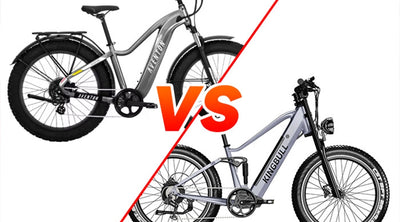
Ebike ComparisonPurchase Guide
Kingbull Rover vs. Aventon Aventure.2: Off-Road Electric Bike Showdown for an Adventure-Packed Journey
In the rapidly evolving landscape of today's market, off-road electric bikes have emerged like mushrooms after the rain, providing adventure enthusiasts with unprecedented and diverse choices. This burgeoning field not only sparks technological innovations but also opens up opportunities for riders to explore uncharted territories. Whether venturing into wild mountains, traversing forested trails, or conquering rugged ridges, these electric bikes have become the ideal companions for adventurers seeking to overcome obstacles and experience the harmonious blend of speed and nature. Faced with such an extensive array of options, this article will compare the Kingbull Rover and Aventon Aventure.2. Through a thorough examination of their performance, design, and features, we aim to present a comprehensive showdown, helping you discover the electric bike that best suits the adventurous spirit within you.
Performance Overview
Kingbull Rover
Aventon Aventure.2
Motor
750W 48V Brushless Rear Hub
750W 48V Brushless Rear Hub
Battery
48V 17.5Ah lithium battery
48V, 15Ah LG Cell
Pedal Assist
5 Levels
4 Levels
Sensor
Speed
Torque
Throttle
Half Twist Throttle
Thumb Throttle
Top Speed
28 mph
28 mph
Range
Up to 60 miles
Up to 60 miles
Weight
77 lbs
77 lbs
Payload Capacity
440 lbs
400 lbs
Frame
6061 Aluminum frame with integrated battery design
Double-Butted Aluminum Alloy
Wheels
26″ x 4″ CST fat tires
26 x 4
Brakes
180mm hydraulic disc brakes
Hydraulic
Gears
Shimano 7 speed
Shimano 8 speed
Display
LCD Colorful Screen with USB
LCD Smart "Easy Read"
soft-tail
Yes
No
Price
$1,699.00
$1,999.00
Motor
Both Rover and Aventure.2 are equipped with powerful 750W 48V Brushless Rear Hub motors. The design of these high-performance motors allows them to deliver robust power during rides, effortlessly adapting to various terrains and inclines. Advantages of brushless motors include lower maintenance requirements, higher efficiency, and smoother power output. Whether for urban commuting or off-road adventures, this advanced motor technology ensures outstanding driving performance for both rover and Aventure.2, providing users with efficient and powerful electric assistance throughout their rides.
Battery
Rover is equipped with a 48V 17.5Ah lithium battery, while Aventure.2 features a 48V 15Ah LG battery. In terms of performance, Rover's battery stands out with higher capacity. However, Aventure.2 gains an advantage in battery quality by utilizing the renowned LG battery cells. It is undeniable that Aventure.2's battery may possess a certain edge in terms of quality. Yet, Rover's battery adheres to high manufacturing standards, ensuring reliability and performance that are equally competitive.
Pedal Assist
Rover offers 5 levels, while Aventure.2 provides 4 levels. This means that Rover has higher flexibility and selectivity in providing personalized electric support, catering to the diverse needs of riders.
Sensor & Throttle
Rover utilizes a speed sensor, which provides assistance by detecting the rider's pedaling motion. This sensor delivers a smooth and natural riding experience, allowing you to start your journey with ease and gradually feel the electric assistance kicking in. The sensor's quick response makes riding smarter and more adaptive, making it well-suited for various scenarios, whether you're carrying children or transporting cargo, ensuring a stable riding experience.
Aventure.2 utilize torque sensors, providing a more intelligent and responsive riding experience. Torque sensors continuously monitor the rider's force applied to the pedals, adjusting the motor's power output accordingly, delivering precise responses to the rider's cycling needs.
In terms of throttle design, the Rover features a half-twist throttle, while the Aventure.2 adopts a thumb throttle. The torque throttle has certain advantages, particularly in off-road cycling. It offers easier operation, especially on rough terrains, allowing riders to have more precise control over power output, enhancing maneuverability and flexibility.
Furthermore, the Rover's handlebars are equipped with rubber material, not only increasing comfort in hand feel but also providing enhanced friction. In off-road environments, this design ensures a secure grip for riders, offering reliable control and further enhancing the riding experience. These clever designs and configurations enable both electric bikes to perform exceptionally well in off-road cycling.
Speed & Range
The Rover boasts a top speed of 28 mph, matched by the Aventure.2 at the same impressive pace. In terms of range, both the Rover and Aventure.2 offer exceptional capabilities, covering distances of up to 60 miles on a single charge. making them equally outstanding choices for riders seeking a balance of speed and range.
Weight & Payload Capacity
Both the Rover and Aventure.2 have a weight of 77 lbs. Although the Rover and Aventure.2 share the same weight, the Rover's impressive 440 lbs payload capacity surpasses the Aventure.2's 400 lbs capacity. This difference in load-bearing capability makes the Rover an ideal choice for a diverse range of riders, providing enhanced versatility for those who require additional cargo space or fall within a broader spectrum of body weights. Whether carrying extra gear for adventurous journeys or offering comfortable support for riders of varying weights, the Rover's higher payload capacity adds an extra layer of adaptability, making it the preferred option for riders with diverse needs.
Wheels
Both Rover and Aventure.2 feature the use of robust 26" x 4.0 fat tire designs. Fat tires offer unique advantages for off-road cycling, providing a larger contact area and improved buoyancy, enhancing the stability of the vehicle across diverse terrains. This design not only increases adaptability to rough landscapes but also ensures a more comfortable riding experience for cyclists.
Additionally, Rover's tires are equipped with reflective strips, a thoughtful feature that enhances visibility in low-light conditions, thereby improving overall riding safety. Especially during nighttime or dim weather conditions, these reflective strips become crucial markers, making it easier for other road users to notice the presence of the rider. This detail underscores Rover as an off-road electric bike that prioritizes safety and practicality.
Brakes
Both the Rover and Aventure.2 are equipped with hydraulic brakes. This shared feature brings several advantages to the table. Hydraulic brakes are known for their superior stopping power and responsiveness. They offer precise control, allowing riders to modulate braking force more effectively, especially in diverse riding conditions. Additionally, hydraulic brakes require less maintenance compared to traditional mechanical systems, providing riders with a reliable and low-maintenance braking solution. Overall, the use of hydraulic brakes on both the Rover and Aventure.2 contributes to enhanced safety and a more enjoyable riding experience.
Display
Rover is equipped with a colorful LCD screen that not only provides intuitive information display but also comes with a USB interface. This color screen not only makes information clearer and more visible but also offers a more personalized experience for users during rides. Additionally, Rover's USB functionality allows riders to conveniently charge their communication devices, ensuring they always maintain sufficient power.
In contrast, Aventure.2 features an LCD Smart "easy read" screen. This design emphasizes clear and easy-to-read information, providing riders with straightforward data display. While it may not have the rich color display of the Rover, its focus on a clean and readable design allows riders to quickly access key information.
Soft-tail
Kingbull Rover is equipped with a soft-tail design, whereas Aventon Aventure.2 does not feature this. The soft-tail design provides Rover with a significant advantage in terms of shock absorption. This unique suspension system helps absorb bumps and vibrations, offering riders a smoother and more comfortable riding experience. Whether navigating rugged mountain terrains or tackling the bumps of city roads, Rover's soft-tail design enhances rider control and comfort remarkably.
Price
The standard prices for Rover and Aventure.2 are $1699 and $1999, respectively. Please note that these are the regular retail prices. However, during promotional periods, there may be adjustments to the prices. We recommend staying tuned to our website for updates and promotions. Feel free to check our website for the latest information, especially during promotional events, to take advantage of potential price reductions.
Conclusion
The Kingbull Rover and Aventon Aventure.2 stand out as top choices for off-road enthusiasts, each offering exceptional support for adventurous journeys through their unique designs and performance features. However, when considering a comprehensive evaluation of cost-effectiveness and performance, I lean towards recommending the Rover. Its outstanding performance provides riders with superior control and safety. As an additional benefit, the Rover comes with a high-lumen front light, offering a clearer nighttime visibility. Therefore, whether seeking exceptional performance or better value, the Rover remains a satisfying choice, bringing riders a more enjoyable and safer off-road experience.
Read more

Tips & Cycling Knowledge
Mechanical vs hydraulic disc brakes. Which are the best brakes.
As a cyclist, recognizing the significance of your bicycle's or e-bike's braking system is crucial. When deciding between mechanical and hydraulic disc brakes, it's essential to comprehend their distinctions along with their respective benefits and drawbacks.
Disc brakes have become the gold standard in the 21st century, with mechanical and hydraulic variations dominating the market. Each system operates distinctly, offering a range of costs along with their own set of advantages and disadvantages to consider.
What are mechanical disc brakes?
A mechanical disc brake is a type of bicycle brake that uses a cable to transmit force from the brake lever to the brake caliper. The brake caliper then uses pistons to apply pressure to the brake pads, which press against a disc rotor mounted to the hub of the wheel.
Working principle of mechanical disc brake:
When the brake lever is squeezed, the cable pulls a lever arm on the brake caliper. This lever arm engages the piston(s), which pushes the brake pads against the rotor. The friction between the brake pads and the rotor slows the wheel down and stops the bike.
Mechanical disc brakes are widely used in bicycles and electric bicycles. Their biggest advantages are low cost and simple maintenance.
What are hydraulic disc brakes?
Hydraulic disc brakes use hydraulic fluid to transfer force from the brake lever to the brake caliper. The brake calipers then use pistons to apply pressure to the brake pads, which press against disc rotors mounted on the wheel hub.
Working principle of hydraulic disc brake:
When the brake lever is squeezed, a piston in the master cylinder forces hydraulic fluid through a hose to the brake caliper. The hydraulic fluid then applies pressure to the piston(s) in the brake caliper, which pushes the brake pads against the rotor. The friction between the brake pads and the rotor slows the wheel down and stops the bike.
Hydraulic disc brakes have powerful braking capabilities and short braking strokes. Nowadays, more and more bicycles and electric bicycles are choosing hydraulic disc brakes.
Mechanical vs hydraulic disc brakes
Hydraulic and mechanical disc brakes each have their own pros and cons. I personally prefer hydraulic disc brakes, but they are not suitable for everyone.
Price
Hydraulic disc brakes cost significantly more than mechanical disc brakes, which also means that hydraulic disc brakes will provide better performance.
Braking travel
Hydraulic disc brakes can provide extremely short braking strokes and are often safer than mechanical disc brakes in emergency situations. At the same time, with hydraulic disc brakes, you don't need to exert as much force on the brake lever, which also provides a more comfortable riding experience.
Brake maintenance
Even as a beginner, learning to maintain mechanical disc brakes is fairly easy. However, due to the complexity of the structure of hydraulic disc brakes, beginners often cannot maintain them. Our more suggestion is to go to a professional bicycle shop for repairs.
Service life
Mechanical braking systems tend to last longer than hydraulic braking systems. And the mechanical braking system is easy to repair, which is the main reason why most riders choose the mechanical braking system.
Therefore, the main advantages of mechanical disc brakes are that they are cheap and easy to maintain. Hydraulic disc brakes provide better braking performance and a more comfortable riding experience.
Which braking system is better for you?
This mostly depends on how you ride.
If you ride trails or mountains and you enjoy faster speeds, hydraulic disc brakes may be better for you. Excellent braking ability is very important to you. In mountain bike racing, mechanical braking systems are rarely seen. There is no doubt that hydraulic braking systems are safer and more reliable.
Although hydraulic disc brakes are excellent, they still have the disadvantages of high cost and troublesome maintenance. Mechanical disc brakes are also a good choice if you just enjoy slow speed riding in the city.
But I definitely recommend hydraulic disc brakes to you. It not only provides more reliable braking performance, but also provides a better riding experience. This is why all Kingbull electric bicycles use hydraulic braking systems.
Conclusion
The overall evaluation of hydraulic disc brakes is definitely higher than that of mechanical disc brakes. As a rider, better braking performance and a better riding experience are particularly important.
Whether you're an off-road rider or a commuter, hydraulic disc brakes can provide you with greater safety and a better riding experience. If price is more a consideration, mechanical disc brakes are also a good choice.
Read more

Ebike ComparisonPurchase Guide
Ultimate electric mountain bike showdown: Kingbull Rover vs. Himiway Cobra
This fall, Kingbull launches three exciting new e-bikes. Cargo electric bike Voyager, with its excellent range and stability, is your best partner for transporting cargo. Rover, a soft-tail all terrain electric bike, has stronger shock-absorbing capabilities and comfort to help you navigate any complex terrain. The folding electric bike LiteRider makes life and games more convenient.
We cover all areas when it comes to bike design. We have always believed that electric bikes will become a new way of life for people and will replace traditional car travel and entertainment. Our long range e-bikes can help you commute, load cargo, travel, camp, explore, and we are constantly upgrading our e-bikes to better meet the needs of different riders.
Ever since e-bikes began to gain popularity, electric mountain bikes have received a lot of attention from riders. Compared with ordinary bicycles, electric mountain bikes are more comfortable and stable to ride, and they can save more energy when climbing hills. The powerful motor allows you to conquer rougher sections and steeper hills.
The Kingbull Rover is a perfect example of this value. As a premium e-mountain bike, the Kingbull Rover offers the smoothest mountain riding experience at a price even lower than other premium e-bike brands.
In this piece, we compare the Kingbull Rover to the Himiway Cobra, both popular electric mountain bikes. Use our electric bike comparison to help you decide.
Kingbull Rover - Softail Electric Mountain Bike
Kingbull Rover provides greater comfort and stability, and its powerful motor and fat tires can help you conquer any rugged road section, providing an unparalleled riding experience.
Battery
Rover is equipped with a 17.5Ah large-capacity battery with a maximum range of up to 60 miles. The powerful power can support riders to explore any environment.
Motor
Kingbull Rover has a 750W brushless motor that provides powerful torque. Whether you are driving on rough roads or climbing hills, it can provide strong support.
Frame
The Rover e-bike is skillfully crafted with a 6061 Aluminum frame that seamlessly incorporates the battery, effortlessly blending robustness with elegance. This frame not only amplifies the bike's resilience but also adds a touch of sophistication, making heads turn as you cruise by.
Speed
Featuring a remarkable maximum speed of 28 mph, the Kingbull Rover presents an ideal means of transportation for urban journeys or adventurous explorations in natural landscapes. Whether you are navigating through bustling city streets or conquering rugged mountain terrain, this electric bicycle offers an abundance of enjoyment and liberation.
Fat Tires
Looking to effortlessly glide through sandy beaches or effortlessly conquer gravel roads? Look no further than the extraordinary 26" x 4.0" CST fat tires featured in the Kingbull Rover. These remarkable tires allow you to effortlessly traverse any terrain, from sand to gravel to pavement, ensuring unrivaled traction, stability, and unwavering confidence throughout your ride.
Weight
Weighing at a mere 77 lbs, the Kingbull Rover presents a remarkable advantage in terms of maneuverability and fatigue reduction, setting it apart from other conventional electric bikes available in the market. This lightweight design allows for effortless navigation, ensuring you remain energized and unworn throughout your ride.
Brake
In unforeseen circumstances, hydraulic disc brakes deliver enhanced safety by swiftly and effectively bringing the Kingbull Rover to a halt. With their remarkable capability to stop within a short span of time, these brakes provide an added layer of security, ensuring your complete peace of mind while riding.
Kingbull Rover vs. Himiway Cobra
Feature
Kingbull Rover
Himiway Cobra
Price
$1,699.00
$2,399.00
Motor
750W brushless gear motor
750W brushless gear motor
Battery
48V 17.5Ah lithium battery
48V 20Ah lithium battery
Range
Up to 60 miles
Up to 80 miles
Top speed
28 mph
25 mph
Weight
77 lbs
88 lbs
Frame
6061 Aluminum frame with integrated battery design
6061 Aluminum frame with integrated battery design
Front Fork
Upgraded alloy suspension
Alloy suspension
Rear Shock
Hydraulic rear shock
Air rear shock
Wheels
26″ x 4″ CST fat tires
26″ x 4″ CST fat tires
Brakes
180mm hydraulic disc brakes
180mm hydraulic disc brakes
Gears
Shimano 7 speed
Shimano 7 speed
Price
If you are in search of an affordable yet high-quality softtail mountain e-bike, look no further than the Kingbull Rover. Priced at a competitive $1,699, it offers exceptional value for your money. In contrast, the Himiway Cobra, priced at $2,399, presents a higher cost option.
Battery Capacity
The Kingbull Rover utilizes a 17.5Ah battery, providing ample power for your rides. On the other hand, the Himiway Cobra boasts a larger 20Ah battery capacity, significantly enhancing the bike's overall range and endurance. With the extra power stored, riders can embark on longer journeys without any concerns of running out of battery.
Maximum range
The cruising range of an electric bicycle plays a vital role in providing riders with freedom and convenience during their rides. The Kingbull Rover offers a commendable maximum range of up to 60 miles, while the Himiway Cobra excels with an impressive range of up to 80 miles. These extended ranges allow riders to enjoy longer journeys without any worry of running out of battery power.
Weight and stability
With a weight of just 77 lbs, the Kingbull Rover establishes itself as a lightweight option, offering a more enjoyable riding experience. Moreover, its lighter body allows riders to tackle more intricate terrains with ease and confidence. In contrast, the Himiway Cobra, weighing 88 pounds, may pose slightly more heft, which could potentially limit maneuverability on challenging landscapes.
Higher Top Speed
With its impressive top speed of 28 mph, the Kingbull Rover delivers an exhilarating and thrilling riding experience. Designed for riders who seek the thrill of speed, this electric bike is an exceptional choice. It enables riders to enjoy a faster and more exciting journey, pushing the boundaries of adventure and excitement to new heights.
Softail electric mountain bike riding
As a senior e-bike enthusiast, exploring intricate terrains using an e-mountain bike can be a wonderful and fulfilling experience. However, it is crucial to acknowledge that traditional mountain bikes cannot be fully replaced by electric mountain bikes. Due to weight restrictions, there is still a higher risk involved in using an electric bike when tackling exceedingly challenging landscapes. It's essential to understand that attempting such a feat could be unsafe and could result in injury or worse. We highly advise that you prioritize safety and take caution when riding, regardless of the bike you choose.
Conclusion
If you are in the market for a mountain e-bike that offers exceptional performance without breaking the bank, look no further than the Kingbull Rover. This electric bike combines a powerful battery capacity and motor to provide outstanding performance on your adventures. With the Kingbull Rover as your trusted companion, you can confidently explore the world and enjoy an unmatched riding experience that will leave you awe-inspired.
Read more




